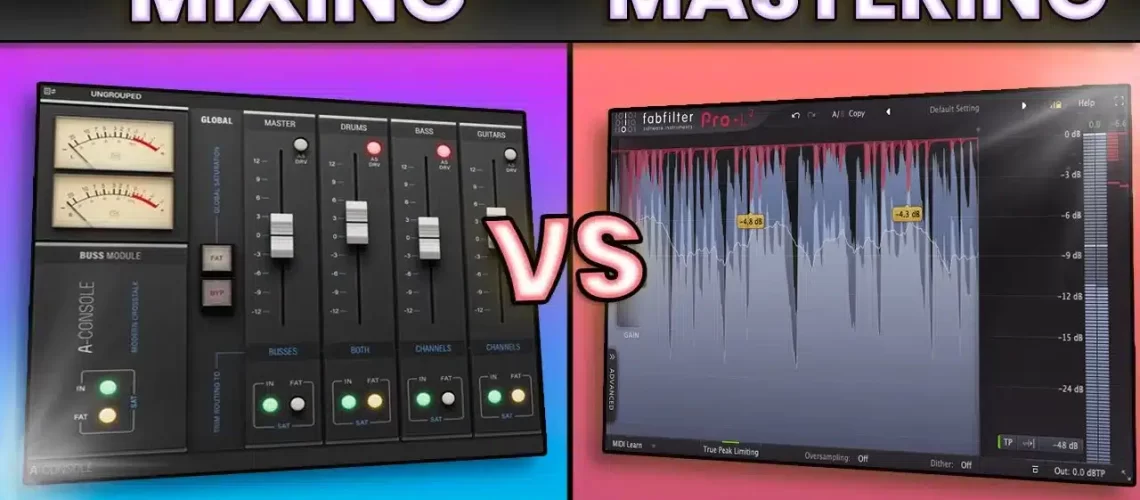Today, we’re going to be diving into the world of mixing vs mastering in 2024.
What is the difference between the two? What are their similarities?
We’ll also touch on the differences in mindset between mixing vs mastering, and a lot more. So let’s get started.
Mixing vs Mastering: a Disclaimer
Mixing and mastering are two different processes that are both fundamental to finishing a professional-sounding track.
But before I continue any further, both mixing and mastering are wormhole topics. So we will not cover every single detail of each process.
Instead, I am going to be outlining each process to give you a solid understanding of why and how we do each one.
If you want to dive deeper, we have detailed guides on mixing here and on mastering here.
What is Mixing?
Mixing is the process of adjusting all of your tracks so that everything in your project fits together.
In general, the bulk of the mixing process comes after the production phase. In the production phase, you focus on sound design, idea generation, and arrangement.
However, during the mixing phase, we’re essentially switching our thought process from designing and creating sounds to putting sounds together and making them gel cohesively.
Mixing always involves the 3 following components:
- Volume: is each track at the appropriate volume?
- Frequency: is each track occupying the right frequency spectrum? Do some frequencies need to be removed or boosted?
- Panning: is each track occupying the right place in the stereo field?

But instead of thinking about one particular sound, I’m thinking about multiple sounds and how they interact with each other. I’m checking the volume of one track relative to the others. I’m checking how frequencies overlap between tracks, and if that needs to be fixed.
That’s the most brief, yet comprehensive explanation of what mixing is.
Want to check this guide in video format? Head over to our YouTube channel 👇
What is Mastering?
Mastering always happens after the mixing stage. Mastering is when the fine-tuning and final polish happens.
The mastering stage aims to ensure that the final product is as good as it can be. This means it should sound good on any type of speaker. It should also sound loud enough compared to other tracks in the same genre, and not have any pops or weird artifacts.
This is why it’s really important to have a final process to iron out our track and make it as good as possible.
Mastering is usually done on one, single stereo track exported from your mixing session. There are exceptions, such as stem mastering, but we won’t cover those in this guide. Common mastering steps include:
Mixing vs Mastering: The Planes of Space
Before we go into any more detail, I want to talk about something called “the planes of space”.
Mixing and mastering are when we start to consider the 3D space of our song. What this means is that within any song that you listen to, there are three planes of space:
- up-down;
- left-right;
- front-back.
“Up-down” refers to the frequency spectrum. We’ve got high frequencies at the top and through the mid-frequencies down to the low frequencies.
Then we have “left-right”, which refers to our stereo spectrum. Pretty self-explanatory: we have a left channel for our left ear and a right one for our right ear. We then have mono in the center, and all of the space in between.

Finally, we have our “front-back” plane of space. This refers to the depth of our song. When something is really up front, it’s going to be a main core element of our track. This could be a vocal for example, or the kick and bass in Techno.
If we want to push something back in the mix, we usually turn it down in volume. We might also add reverb and or add some filtering.
By combining these 3 planes of space, we can get each element of our song to fit where it belongs, and work harmoniously with the other elements of our track.
Now let’s explore what mixing is in more detail.
Mixing in More Depth
Even if you had no idea what mixing was before reading this, chances are you’ve already done some mixing-related tasks.
If you’ve ever listened to a sound and thought: “That’s a little bit too loud, I’m going to bring that down a little bit”, that’s mixing.
This is a fundamental concept called “fader balancing” – and this is the first step of our mixing process. This is often already done during the writing process. As you’re producing the song, you’re balancing your faders, pushing certain sounds up or down.
However, I also personally really like to do this all at once again after I’ve finished the entire arrangement. One trick many people use is to set all their faders to zero. You then increase the volume of each track one by one, starting with the most important one (kick and snare for example).
Bringing sounds from “quiet” to “loud” makes it easier to hear how everything gels together rather than going from “loud” to “quiet”.
Try this the next time you’re mixing your drums. Bring all the tracks to zero. Then, start with your kick and bring it up to a healthy level. Next, bring up your snare until it sounds balanced with your kick. Finally, bring up your hats and percussive layers one by one.
You can do the same process with the bass and all the other elements of your song. Starting off with a really solid fader mix from the get-go is really going to help your mixdown.
Step 2 of the mixing process is removing any unwanted frequencies or artifacts. We do this using our mixing utility tools such as EQs and compressors.

I would go through every single track and make sure that there is an EQ on there. If it’s a high-end element, I’m removing low-end that I don’t need. The idea is to make sure each track is confined to its specific frequency range. This is the top-bottom plane of space.
Finally, step 3 is thinking about the different planes of space and trying to get everything to fit together. This is also when we can get creative and have a little bit of fun with effects.
At this stage, I may want to pan particular elements to the left or right. Do I want elements to be more wide or more mono? Do I want elements to be forward in the mix or further back? The goal is to make our mix sound cohesive.
Mastering in More Depth
In mastering, we’re working with an exported mixdown. This typically involves one track with two channels (left and right).
At this stage, we’re simply trying to get our song ready for listening.
When exporting our mixed track (called “pre-master”), we should leave enough headroom. This is the “room” left between the loudest part of our song and the “0dB” mark. Without enough headroom, our track will be digitally clipped (which we want to avoid).
In mastering, the biggest change that is happening is bringing the volume of your track up. We want to do this with a “limiter” because a limiter will increase the volume without introducing distortion.
We’re also fixing any technical small problems that might have occurred. The mastering stage can be very technical and intricate, but I’m going to give you a simplified 3-step process.
Glue compression
The first step of this 3-step process is to load a Glue Compressor onto our master. This will add some soft compression to catch some of the peaks in our track. I’m going to go through my project, and bring down the threshold, and I want to see the needle jumping just a little bit. In the range of about zero to four decibels is about right.
We’re essentially trying to soften our track before it goes into a limiter so the limiter doesn’t have to work as hard to compress our track.
If you don’t have a limiter, you can use the Ableton built-in limiter. But I would personally recommend getting a third-party limiter such as the Fabfilter Pro L2. In any case, bring the threshold down until you get the track as loud as possible without hearing any distortion or weird pumping.

The 3rd step is metering. For this, you can use Youlean Loudness Meter, which is a free plugin.
What we’re aiming for here is around about -9 LUFS Integrated. If you don’t know what LUFS is, make sure to check out our guide here. This number can vary based on the genre of music you produce and the streaming service, so make sure to check the guidelines online.
Note that a mastering engineer is going to do a lot more than just this 3-step process. There’s a whole suite of other things like multiband compression, stereo imaging, saturation, etc. that often go into the mastering process. But this 3-step process should get you started.
A Quick Recap on Mixing vs Mastering
That’s a wrap for this guide. Hopefully, you now have a good overview of the differences between mixing and mastering.
In a nutshell, mixing involves adjusting individual tracks within a song: vocals, drums, bass, etc. The goal is to balance their levels, panning, EQ, and more to create a cohesive sound. Mastering, on the other hand, is the final step that enhances the overall mix by applying EQ, compression, and limiting. The goal is to ensure the track sounds consistent and optimized across all playback systems.
Did we miss out on anything? Anything unclear? Feel free to drop us a line over at [email protected]




